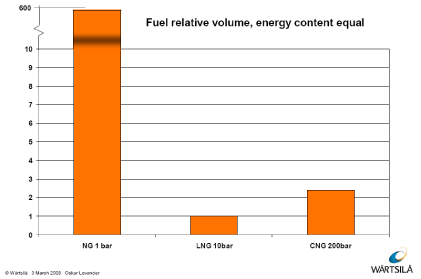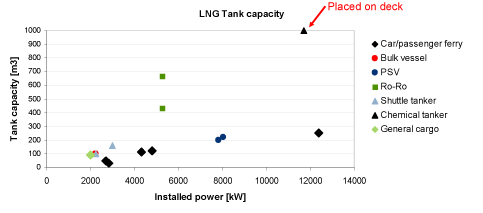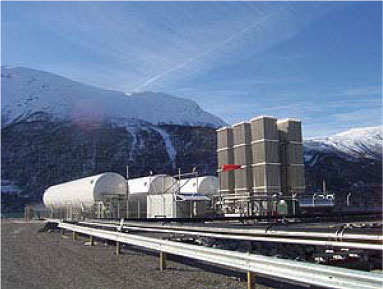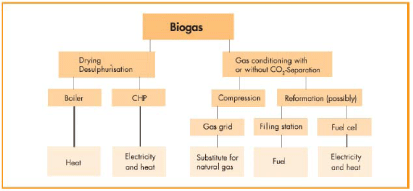Natural gas for ship propulsion in Denmark
2 Experiences with ships
- 2.1 Natural gas as LNG or CNG in ships
- 2.2 Technologies for supplying gas propulsion
- 2.3 Distribution of LNG
- 2.4 Biogas as a contributing alternative
- 2.5 Summary and conclusions
2.1 Natural gas as LNG or CNG in ships
Conventional ship engines have the potential of converting to a lean gas engine or dual fuel engine design. The main issue is the supply of the LNG or CNG to the vessel, the space onboard for tanks and the operation radius of the vessel. According to MAGALOG[6] report there are two time-bound factors, which have an effect on implementation of the lean gas driven engines:
- Introduction of LNG-fuelled ships is more likely to happen by building new ships equipped for this, than by converting existing ships from conventional fuel to LNG. Ships usually have economic lifes of 30 years or more, and it should therefore take at least 30-40 years to fully convert an established shipping segment. However one might see a more rapid switch to cleaner technologies within the ECA’s, by transfer of more polluting ships to operation in outside waters.
- Some shipping segments will be better suited than others to introducing LNG early (long term contracts and fixed routes). An important reason for this is that the development of cost effective supply systems for LNG bunkering needs to be undertaken in steps over a length of time, focusing first on certain segments and ports.
As mentioned earlier this study is concerned with ferries and short sea shipping and the challenges and options in these sectors in Denmark. Very little actual experience is available with natural gas in shipping except on LNG rather than CNG and most data will be from LNG vessels and facilities.
2.1.1 The space consideration
Natural gas at atmospheric pressure and room temperature has a very low energy density, and hence a large volume. In ships the space available for fuel tanks is generally limited, so as high as possible energy density for the fuel is preferable. Cooling the gas to the point of liquefaction and applying a moderate pressure increases the energy density 600 times, which, however, is still only about half the energy density of oil. Compressing the gas to 200 bar CNG instead of cooling it also significantly increases the energy density compared to uncompressed natural gas. LNG is however the most volume-effective of the two options. In short, LNG requires approximately 2 times the fuel volume of oil, and CNG (at 200 bar) requires 5 times the volume of oil. In addition, the added insulation and sub optimal tank shape of LNG and CNG further increases the tank requirement for a given ship and sailing range.

Figure 2‑1 Relative fuel volume for equal energy content of natural gas
2.2 Technologies for supplying gas propulsion
2.2.1 Engines suppliers
The basic need for engines with a capacity for using gas in the combustion process is met. It is beyond the scope of this study to go into the details of the various commercial solutions, but more information on the different engine types and the producers can be found in Chapter 6 and Appendix 2. The four main suppliers of gas engines are Rolls-Royce, Wärtsilä, Mitsubishi and MAN. Rolls-Royce and Wärtsilä are also suppliers of complete engine and propulsion design and supply packages as well as complete ship designs. Wärtsilä and MAN are the main suppliers of dual fuel engines whereas Rolls-Royce and Mitsubishi are the main suppliers of gas engines. The large fast ferries are often powered by diesel engines and/or gas turbines in various propulsion system configurations delivered by specialist companies. The efficiency of the individual systems does differ, but no further consideration is given to the detailed efficiency of the individual systems in the study.
2.2.2 LNG propulsion in ships
The World’s first ferry with LNG propulsion was the Norwegian MF Glutra built in 2000, and since then a number of ships have been built. All ships (other than gas carriers) built with LNG propulsion and six ships currently under construction have been built to DNV class. Two small LNG fuelled gas carriers also regularly operate in Norwegian waters (one DNV and one BV class). In addition to the ships listed and mentioned, seven cargo ships and two ferries have applied for funding for newbuilds with LNG propulsion through the Norwegian NOx Fund.
2.2.3 LNG storage onboard
In existing ships LNG is stored in cylindrical, double-wall, vacuum insulated stainless steel tanks. The tank pressure is defined by the requirement of the engines burning the gas and is usually less than 5 bar. The practical spaces required in the ship increases four times when taking into account the squared space around the cylindrical LNG tank. If compared to a Marine Diesel Oil (MDO) tank located above a double bottom, the total volume difference is smaller, about 3.0. The typical tank size is less than 200 m³.

Figure 2‑2 The LNG tank sizes for some selected ships already built or under construction
2.2.4 CNG propulsion technology in ships
Internationally, there are only few ships operating on CNG today. These are three tourist boats in Russia, two canal boats in Netherlands, one bulk carrier in Australia, two ferries in Canada and one river boat in US. The details of the identified projects of natural gas utilisation in water transport include:
- Accolade II – cargo ship Adelaide, Australia 1982 CNG
- Klatawa – ferry Vancouver, Canada 1985 CNG (26 cars, 146 passengers)
- Kulleet – ferry Vancouver, Canada 1988 CNG (26 cars, 146 passengers)
- Heineken – pleasure boat Amsterdam, NL 1992 CNG
- Mondriaan, Escher, Amsterdam, NL 1994 CNG Corneille – pleasure boats
- Tourist ship St. Petersburg, Russia 1994 CNG
- Elisabeth River I - ferry Norfolk, Virginia, USA 1995 CNG (149 passengers)
- Tourist ship Moscow 1999 CNG
- Rembrandt, Van Gogh, Amsterdam, NL 2000 CNG Jeroen Krabbé – pleasure boats
2.2.5 CNG storage onboard
The Canadian ferries are refuelled twice a day using about 3-4 minutes each time. The on-shore compressor station store the gas at 250 bar, filling the on board storage to about 160 bar (Einaar & Haavik, 2000). Compared with LNG, an equal energy content of CNG requires almost 2.5 times more volume, thus requiring some 5 times the storage space of MDO.
2.2.6 LNG bunkering configuration in Norway
For the Norwegian gas fuelled car and passenger ferry Glutra, the two LNG tanks onboard are 32 m³ each. Refuelling takes place every 4-5 days and takes one hour for a truckload of 40 m³ of LNG. Having this storage capacity onboard, storage at the ferry berth was not necessary. The refuelling takes place when the ferry is docked for the night and no passengers are onboard (Einaar & Haavik, 2000).
For the Norwegian gas fuelled passenger ferries Tidekongen, Tidedronningen and Tideprinsessen operating from Oslo, the LNG tank onboard is 29 m³. The ships are fuelled approximately once a week from a dedicated truck with typically 50 m³ capacity.
2.3 Distribution of LNG
This section addresses LNG onshore infrastructure available in Norway and Europe today and what is needed for supply as fuel for a fleet of short sea vessels in the near future.
Over the past four decades LNG trade has grown to become a large and flexible market. The expected growth in natural gas demand can either be met by expansion of small-scale liquefaction capacity or by imports from the international LNG spot market.
2.3.1 Current LNG infrastructure
LNG as a bunker fuel is already introduced in Norway, but presently not available for ship bunkering in Denmark. In Norway, LNG is transported either by small scale LNG carriers or by truck from regional LNG production and/or storage terminals to local storage terminals or bunkering stations. LNG has also been supplied from large LNG carriers to coastal LNG carriers.
2.3.1.1 LNG production plants
There are five LNG production plants in Norway. A list of the suppliers, production plants and their capacity is given in Table 2-2.
| Supplier | Production Plant | Start-up (year) |
Capacity (tonnes/year) |
|---|---|---|---|
| Gasnor | Kollsnes | 2003 (Kollsnes I) and 2007 (Kollsnes II) |
120000 |
| Gasnor | Karmøy (Snurrevarden) | 2003 | 20000 |
| Lyse | Risavika | 2010 | 300000 |
| Statoil | Melkøya | 2007 | 4100000 |
| Statoil | Tjeldbergodden | 1997 | 15000 |
It is noted that Statoil’s plant at Melkøya is primarily dedicated to export on long term contracts to Spain and the US.
2.3.1.2 Downstream distribution of LNG
From LNG production plants and potential large import terminals, LNG may be further distributed to smaller terminals and/or fuel bunkering stations. Today LNG is distributed by ship, semi-trailers or a combination of the two. LNG is also supplied from large LNG carriers to coastal LNG carriers.

Figure 2‑3 Pioneer Knutsen and Höegh Galleon conducting a ship to ship transfer of LNG cargo
For storage of LNG, double shell cylindrical pressurised vessels are used. Powder-vacuum or multi-layer-vacuum insulation ensures long time storage with limited vapourisation. The storage tanks in a bunkering terminal for ships will have a capacity of 500 to 700 m³ LNG (Marintek 2008). The tanks are placed in series according to the storage capacity required. Capacity can be increased over time by adding storage tanks.
For transfer of LNG from the storage tanks to the ship, insulated piping with a pipe connection or marine loading arm is used. The distance from the terminal to the quay should be as short as possible to minimise boil-off. From the receiving and storage terminals the LNG can be transported to fuel bunkering stations.

Figure 2‑4 LNG receiving and storage terminal (Source: MARINTEK)
2.3.1.3 LNG import and export terminals in Europe
There are a number of LNG import terminals in Europe and terminals under construction.
2.3.1.4 Transportation of LNG
Future transportation of LNG from production sites or from larger carriers may be expected by the same type of small LNG carriers serving a range of terminals and bunkering stations along the Norwegian coast today. Construction time for these ships allows market needs to be met in due time for demand growth.
2.3.1.5 Downstream distribution
Distribution of LNG as fuel is considered most realistic through the distribution system that is already established for ship bunkering. The bunkering stations offer various qualities of hydrocarbon fuels, and many of them should be able to establish the necessary equipment safety procedures to also offer LNG without extensive investment needs.
2.3.1.6 LNG tanks on quay
The stationary tanks are served by either trucks or small LNG carriers. The instalment of a new LNG terminal in Sarpsborg (Norway) was budgeted to 85 mNOK (10.8 mEUR) for 5 x 700 m³ LNG tanks. This facility is served by the small LNG carrier Pioneer Knutsen from the LNG plants in Kollsnes and Karmøy (Gasnor 2009).
2.3.2 Distribution of CNG
The distribution of CNG is more available in countries with developed gas distribution grid for daily use in households. This is generally the case for the European continent and UK. Arranging CNG bunkering stations for ships should therefore be considerably easier to achieve than LNG bunkering, and less costly. Also one escapes the energy-demanding process of LNG liquefaction. The gas is typically transported at approximately 70 bar in the main grid, and reduced to 4-5 bar near the end users. For marine use the gas would have to be compressed to 200-250 bar at the bunkering station.
2.4 Biogas as a contributing alternative
Biogas production is a proven technology, which still has great development potential. To produce biogas a biological decomposition process occurs in which anaerobic microorganisms break down organic material. Degradation takes place in a fermentation tank, a reactor from which the gas is collected and any substrate and debris removed.
Biogas can be used in as many different ways as natural gas. Figure 2-4 shows the options available for the use of this versatile source of energy. At present, biogas is mostly employed in combined heat and power plants, but it could also be used in cooling facilities or as a substitution for natural gas as a fuel. It could also be injected into the gas grid, but will in that case require upgrade to match the quality of natural gas[7].

Figure 2‑5 Biogas treatment procedure
In Denmark, biogas is today utilised locally at cogeneration plants and the advantage is that no investments in further treatment are needed. The treatments to upgrade biogas include de-sulphurisation, CO2 separation and possibly addition of propane gas.
The CO2 must to be stripped from the biogas before entering the Danish natural gas net to establish the high calorific value the North Sea natural gas has. Propane can also be added to obtain the sales quality before entering the gas grid. The extra cost of treating biogas to an extent that matches the North Sea natural gas is 1.09 Danish kroner (0.15 EUR) per cubic meter bio-methane.
One advantage of injecting biogas to the grid is that a surplus of biogas during the summer can be utilised: biogas is produced in an even volume during a year but the need of the energy changes from summer to winter, and any biogas plants have to cool off the biogas instead of using it during the summer time, which gives a lower efficiency of the biogas[8].
Regarding climate issues, the special advantage of using biogas is obviously that the emission of green house gasses is reduced. However, the use of manure for biogas rather than distributing it on fields will also reduce the nutrient load on the Danish lakes and streams.
It is the strategy of the Danish government with its “Grøn Vækst-plan” that half of the Danish manure shall be used as biogas in 2020. The biogas will replace almost 10% of the daily natural gas consumption[9]. Already in 2011 it is expected that the first biogas would enter the Danish Natural gas net.
The main tasks of “Grøn Vækst-plan” concerning biogas are as follows:
- A pool of 85 million Dkr (11.4 mEUR) per year the first three years from 2010 to 2012. Construction subsidy of up to 20% when building of a biogas plant.
- A pool of 15 million Dkr (2 mEUR) per year to ecological biogas plant. Construction subsidy of op to 20%.
- Amendment of the Planning Act, municipalities must involve localisation of biogas plants in the planning.
- Equal subsidy for distribution of biogas to the cogeneration plant and the natural gas net.
- Subsidies for planting energy crops from 2010 to 2012.
When the plan is fully integrated it is expected that the Danish biogas production will be of approx. 19 PetaJoule (PJ) in 2020. However, most of the biogas production is expected to be utilised in local plants and only a fraction of the biogas will be upgraded to the Danish gas grid. Nevertheless, for “use” in the shipping sector the biogas could be traded commercially through a certificate system, known from green electricity[10].
2.5 Summary and conclusions
The technical developments needed to introduce natural gas for propulsion is available for shipping both for ferries and the short sea shipping. For LNG the experiences with onshore and onboard installations are recent and during the coming years the knowledge base will be continuously expanding due to new developments. For CNG the development for the shipping sector appears not to have progressed much over the last decade, although considerable information is available from land transport. The use of upgraded biogas in gas driven engines is not problematic technically, but may not be feasible unless biogas is injected and distributed with the natural gas grid and supplied with the natural gas bunkering facility.
[6] MAGALOG (2008) report (p. 3)
[7] From Deutsche Energie-Agentur GmbH (dena)
[8] Knud Boesgaard Sørensen, Energinet.dk: Ingeniøren (Biogas kan gøre naturgasnettet stuerent)
[9] Source: Energinet.dk, Forsyningssikkerhedsplan (p. 57)
[10] Source: Ingeniøren 11. January 2010: “Danmark er klar til at sende biogas ud I naturgasnettet”
Version 1.0 November 2010, © Danish Environmental Protection Agency